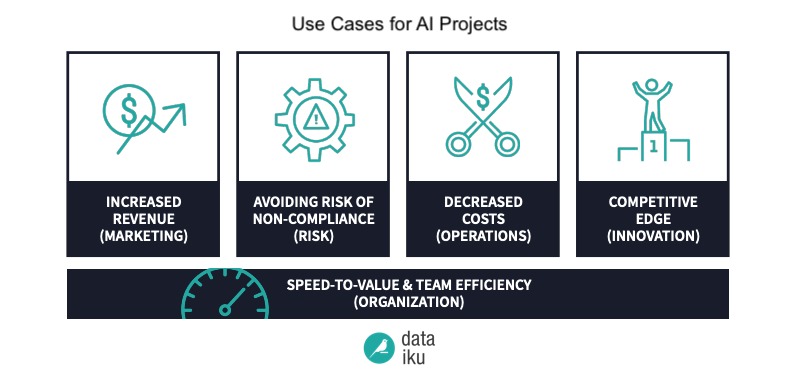6 Steps to Leading a Successful AI Project Sponsored Content by Dataiku
As hype around AI continues to grow, more and more organizations are feeling the pressure to modernize their business. But how to choose the right project? With dozens of potential use cases but limited resources, it is important to prioritize projects that have both high business value and a high likelihood of success.
Who will the project benefit?
Identifying the intended target audience is a critical step in defining an AI project. One important consideration is recognizing that “audience” doesn’t necessarily have to be external - the people benefiting from an AI project can certainly be employees inside the organization
How will the project specifically improve experience or outcomes (and how can this impact be measured?
With a target audience identified, it is then important to consider exactly how the AI application or system will improve that audience’s experience. This “how” should be as quantitative as possible in order to show the return on investment (ROI) of the AI system once implemented.
If the “how” is not clear, then scratch the potential project off the list. AI use cases (especially early ones when garnering organizational-wide support for AI efforts) should focus on opportunities with real and measurable business results.
Why is using AI for this purpose better than existing processes?
It is easy to be seduced by the idea of AI becoming a new “easy” button. But new doesn't always mean more valuable - when weighing the pros and cons of various AI projects, consider whether the anticipated benefits justify the time and investment required to replace an existing process.
What are the upside if the project succeeds as well as consequences if it fails?
No one likes to think about AI projects failing before they begin, but the reality is that 87 percent of data science projects never make it into production. So it is important to evaluate the consequences should the worst happen.
- Will there be significant damage to brand reputation or customer trust?
- Will there be damage to the level of organizational trust in AI projects and the ability of data teams to execute?
- Are there risks regarding regulatory compliance or customer privacy?
Where will the data for the project come from, and does it already exist?
A disconnect occurs when organizations want to implement cool AI solutions but don't have the data readily at hand for the specific task. Those businesses tackling first AI projects might consider selecting initial projects that only rely on internal data rather than ones that heavily rely on third-party sources or custom-manufacturing large quantities of training data (think Stanford's Snorkel, Amazon's Mechanical Turk, or Google's AI Platform Data Labeling Service).
When should an initial working prototype and, subsequently, a final solution in production be delivered?
AI project timelines should not only include time for development and a deadline for a working prototype, but also deadlines for deployment into production and for second (or third) iterations. AI projects fit well into the MVP methodology because the best way to see how a machine learning model performs is in production, so the key to successful projects is operationalizing early, adjusting, and pushing new versions often.
Today's most successful organizations have embraced the idea that effectively leveraging data and technology can not only drive competitive advantage, but also improve the experiences of both their employees and customers. But it’s important to be strategic and deliberate when planning an organization's AI strategy. Using these six questions as a framework or steps to getting started will help avoid false starts on AI projects that are ill-defined and create an environment for success.












